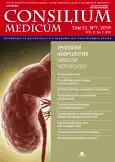Effect of antibacterial agent PK/PD index on efficacy of lower urinary tract infection therapy
- Authors: Dukhanin A.S.1
-
Affiliations:
- Pirogov Russian National Research Medical University
- Issue: Vol 21, No 7 (2019)
- Pages: 69-74
- Section: Articles
- URL: https://ogarev-online.ru/2075-1753/article/view/96841
- DOI: https://doi.org/10.26442/20751753.2019.7.190509
- ID: 96841
Cite item
Full Text
Abstract
Full Text
##article.viewOnOriginalSite##About the authors
Aleksandr S. Dukhanin
Pirogov Russian National Research Medical University
Email: das03@rambler.ru
D. Sci. (Med.), Prof. Moscow, Russia
References
- Asín-Prieto E, Rodríguez-Gascón A, Isla A. Applications of the pharmacokinetic/pharmacodynamic (PK/PD) analysis of antimicrobial agents. J Infect Chemother 2015; 21 (5): 319-29.
- Dukhanin A.S, Patrashev D.V, Ogurtsov S.I. Intracellular ph in thymocytes at the early stages of apoptosis and necrosis. Bull Exp Biol Med 1999; 128 (4): 991-3.
- Sergeev P.V, Galenko-Yaroshevskii P.A, Khankoeva A.I, Dukhanin A.S. A study of the mechanism of action of befol on Ca2+ metabolism in cardiomyocytes using a fura-2 fluorescent probe. Bull Exp Biol Med 1996; 121 (3): 265-7.
- Onufrak N.J, Forrest A, Gonzalez D. Pharmacokinetic and Pharmacodynamic Principles of Anti-Infective Dosing. Clin Ther 2016; 38(9): 1930-47.
- Страчунский Л.С., Белоусов Ю.Б., Козлов С.Н. Практическое руководство по антиинфекционной химиотерапии. https:// http://www.antibiotic.ru/ab/ @@Strachunsky L.S., Belousov Yu.B., Kozlov S.N. Practical Guide to Anti-infective Chemotherapy. http:// www.antibiotic.ru/ab/ (in Russian).]
- Kapoor G, Saigal S, Elongavan A. Action and resistance mechanisms of antibiotics: A guide for clinicians. J Anaesthesiol Clin Pharmacol 2017; 33 (3): 300-5.
- Owens R.C, Shorr A.F. Rational dosing of antimicrobial agents: Pharmacokinetic and pharmacodynamic strategies. Am J Health Syst Pharm 2009; 66 (Suppl. 4): S23-S30.
- MacDougall C, Chambers H.F. Aminoglycosides. In: Goodman & Gilman’s: The Pharmacological Basis of Therapeutics, 13th Ed., edited by Brunton LL, Hilal-Dandan R, Knollmann BC, NewYork, McGraw-Hill Education, 2017; p. 1039-48.
- Sab A, Tomas A, Tomić N et al. Pharmacokinetic/pharmacodynamic based dosing of ciprofloxacin in complicated urinary tract infections. Bangladesh J Pharmacol 2015; 10: 621-6.
- Szałek E, Tomczak H, Kamińska A et al. The PK/PD index for ciprofloxacin in critically ill patients. Anestezjologia i Ratownictwo 2010; 4: 409-13.
- Eyler R.F, Shvets K. Clinical Pharmacology of Antibiotics. Clin J Am Soc Nephrol 2019. doi: 10.2215/CJN.08140718
- Levison M.E, Levison J.H. Pharmacokinetics and Pharmacodynamics of Antibacterial Agents. Infect Dis Clin North Am 2009; 23 (4):791-vii.
- Ventola C.L. The antibiotic resistance crisis: part 1: causes and threats. Pharm Ther 2015; 40 (4): 277-83.
- Blair J.M.A, Webber M.A, Baylay A.J et al. Molecular mechanisms of antibiotic resistance. Nature Rev Microbiol 2015; 13 (1): 42-51.
- Drlica K. The mutant selection window and antimicrobial resistance. J Antimicrob Chemother 2003; 52: 11-7.
- Aldred K.J, Kerns R.J, Osheroff N. Mechanism of Quinolone Action and Resistance. Biochemistry 2014; 53 (10): 1565--74.
- Blondeau J.M, Zhao X, Hansen G, Drlica K. Mutant Prevention Concentrations of Fluoroquinolones for Clinical Isolates of Streptococcus pneumoniae. Antimicrob Agents Chemother 2001; 45 (2): 433-8.
- Drlica K. The mutant selection window and antimicrobial resistance. J Antimicrob Chemother 2003; 52: 11-7.
- Barber A, Norton J, Spivak A, Mulvey M. Urinary tract infections: Current and emerging management strategies. Clin Infect Dis 2013; 57: 719-24.
- VanScoy B.D, McCauley J, Ellis-Grosse E.J et al. Exploration of the Pharmacokinetic-Pharmacodynamic Relationships for Fosfomycin Efficacy Using an In Vitro Infection Model. Antimicrob Agents Chemother 2015; 59 (12): 7170-7.
- Novelli A, Rosi E. Pharmacological properties of oral antibiotics for the treatment of uncomplicated urinary tract infections. J Chemother 2017; 29 (Supp1.): 10-8.
- Dalhoff A, Schubert S, Venteb A. Pharmacodynamics of Finafloxacin, Ciprofloxacin, and Levofloxacin in Serum and Urine against TEM- and SHV-Type Extended-Spectrum-b-Lactamase-Producing Enterobacteriaceae Isolates from Patients with Urinary Tract Infections. Antimicrob Agents Chemother 2017; 61 (5): e02446-16.
- Davis S.S. Formulation strategies for absorption windows. Drug Discov Today 2005; 10 (4): 249-57.
- Arza R.A, Gonugunta C.S, Veerareddy P.R. Formulation and evaluation of swellable and floating gastroretentive ciprofloxacin hydrochloride tablets. AAPS Pharm Sci Tech 2009; 10 (1): 220-6.
- Harder S, Fuhr U, Beermann D, Staib A.H. Ciprofloxacin absorption in different regions of the human gastrointestinal tract. Investigations with the hf-capsule. Br J Clin Pharmacol 1990; 30 (1): 35-9.
- Lopes C.M, Bettencourt C, Rossi A et al. Overview on gastroretentive drug delivery systems for improving drug bioavailability. Int J Pharmaceut 2016; 510: 144-58.
- Fourcroy J.L, Berner B, Chiang Y.K et al. Efficacy and safety of a novel once-daily extended-release ciprofloxacin tablet formulation for treatment of uncomplicated urinary tract infection in women. Antimicrob Agents Chemother 2005; 49 (10): 4137-43.
- Hickerson A.D, Carson C.C. The treatment of urinary tract infections and use of ciprofloxacin extended release. Expert Opin Investig Drugs 2006; 15 (5): 519-32.
- Mirone V, Fusco F, Taglialatela D et al. Efficacy and safety of ciprofloxacin XR 1000 mg once daily versus ciprofloxacin 500 mg twice daily in the treatment of complicated urinary tract infections. J Chemother 2009; 21 (6): 651-60.
- Иремашвили В.В. Новое в лечении инфекций мочевых путей: ципрофлоксацин с замедленным высвобождением. РМЖ. 2008; 16 (5): 312-5. @@Iremashvili V.V. New in the treatment of urinary tract infections: sustained release ciprofloxacin. RMJ 2008; 16 (5): 312-5 (in Russian)
- Talan D.A et al. Once daily, extended release ciprofloxacin for complicated urinary tract infections and acute uncomplicated pyelonephritis. J Urol 2004; 171 (2 Pt 1): 734-9.
- Rasko D.A, Sperandio V. Anti-virulence strategies to combat bacteria-mediated disease. Nat Rev Drug Discov 2010; 9 (2): 117-28.
- Cantas L, Shah S.Q.A, Cavaco L.M et al. A brief multi-disciplinary review on antimicrobial resistance in medicine and its linkage to the global environmental microbiota. Front Microbiol 2013; 4: 1-14.
- Bjarnsholt T, Ciofu O, Molin S et al. Applying insights from biofilm biology to drug development - can a new approach be developed. Nature Rev Drug Discovery 2013; 12: 791-808.
Supplementary files






